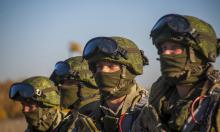Tamers of hurricanes
Russian scientists have approached to unriddling the nature of such mysterious atmosphere phenomena as hurricanes, tornadoes, and typhoons. It could sound strangely, though science does not know much about them. For the time being, it is only known that hurricanes’ “parents” are air masses going up from terrestrial surface, which become very powerful, when some factors coincide, in the atmosphere’s border level (at a height of 300 m). Namely at the height of 300 m, according to some meteorologist scientists, the solution of many earth catastrophes’ reasons lies. Therefore, Russian scientists seem to have good chances to tame hurricanes.
Attacking a thunder storm At a distance of 106 km from Moscow, in the city of Obninsk, on the territory of Taifun (Typhoon) scientific and production association, there is a unique, 312 m high engineering construction. This technically complicated high-rise construction is literally full of equipment. Today, this mast is eyes, ears, and hands of Russian meteorologists. From the tower, they receive information about chemical and radioactive pollution of air, about winds’ speed and direction, about atmospheric pressure, and relative air moisture. All the data arrive in the measuring centre at the foot of the mast, where they are being overworked. Namely thanks to the Obninsk meteorological mast, a series of natural and man-caused catastrophes were modulated. For example, a unique calculation system for radioactive pollution of some territory in case of nuclear accident was created. Though, this system allows to calculate the exact scale of the pollution, in contrast to that calculations made after Chernobyl tragedy, when people were simply resettled at a distance of 30 km from the epicentre. The secret mast was build in 1958, with then-only purpose: to control the atomic power station built four years earlier, the first one in the world. The creators of the station wanted to know the quantity of radioactive aerosols penetrating into the atmosphere. Therefore, a new scientific direction appeared – nuclear meteorology. Apropos, the height of the Obninsk mast was calculated in a simple way: it must have been higher than the atomic power station’s smoke-stack. At that time, it was a fantastic project. Today, one hardly knows that instead of the 300-m-high mast, a similar, though 1000-m-high construction should have been built on the border between Kaluga and Bryansk regions. Though, even the Soviet power, which liked great projects and huge things, could not afford it to it. As a result, the Obninsk meteorological mast appeared, the highest in Europe. Apropos, it still belongs to the highest construction in the world - after CN Tower in Toronto (553 m), Ostankino TV tower (540 m), TV towers in Beijing (405 m), Berlin (365 m), and Tokyo (333 m). Today, the Obninsk mast lost its “nuclear” purpose. Now, its purpose is to study tornadoes and hurricanes. Obninsk scientists state that solution of these phenomena’s nature is not far off, as well as founding methods of fight with them. The reason of hurricanes and tornadoes’ destructive power was almost found out, when the scientists tried to suppress cumulus nimbi. It was proved that germs of atmospheric catastrophes – ascending air flows – could be dissipated with special reagents, while spreading them from aircraft. A dangerous mass ascending to the air could be easily localized at the early stage, though at a height of 8,000 m the hurricane could not be averted. Therefore, the main task is to track the dangerous ascending flow. According to the scientists, to realize this task, four points must be found where the powerful air flows are born, meteorological monitoring in the centres of hurricanes’ origin must be arranged and scientific methods of local forecast composed. The mast in Obninsk is an ideal ordnance yard for working out unique technologies. Apropos, so far, there is no effective way in the world to tame hurricanes, tornadoes, and typhoons. Only last year, an American technological company declared creation of a miracle powder to fight with tornado. Thanks to its structure, the substance is said to be capable to absorb 2,000 times more moisture than the powder’s weight. The moisture is being crystallized and turned into small pieces of ice, which fall on earth without injuring either people, or environment. Though, this is as for fighting with elements, and what about averting cataclysms? Taifun scientific and production association’s director general, Alexei Orlyansky told about the association’s latest experiments in the field. For example, in the association, there is a frame with aerosol chamber with a volume of 3,200 cubic metres, where different geophysical processes are being modulated. In the system consisting of two articulated pressure chambers, clouds and fogs are being created, with which Obninsk scientists try to fight, because that natural phenomena are still the main obstacle in work of air and water transport. One more direction of the research is an attempt to fight with frost, including creation of artificial fogs. Already in the nearest future, experiments like that will be carried out in several conservatories of Moscow region. One more task Obninsk scientists try to accomplish is disseminating of hail clouds. Now, Alazan anti-hail missiles belonging to a new generation are being tested. The project is secret because the creation is highly effective and more profitable than similar creation of foreign production. It is known that to disseminate a huge hail cloud, at the maximum 8 missiles of the kind are necessary, while each costs about 200 dollars. At the height The territory around the mast is surrounded with a fence with barbed wire, though the high secrecy of the object is over. Earlier, the mast was guarded by a dozen of armed soldiers, while now only two women watch on the check points. At first, you get to the measuring centre. Rows of automatic recorders attached to the cables and sensors are established on the mast. Here, there is also the control panels of the person on duty, who receives fresh information about meteorological conditions. Totally, seven people work in the station. One of them is Alexandr Balash, laboratory assistant, who perfectly knows the mast. To reach the 300-m height, one should use a small lift. Sometimes, when the lift does not work, the workers of the station climb on foot, using a vertical ladder, which takes at least an hour. However the lowering is two times faster. Though, while expecting visitors, the workers manage to keep the lift in operative condition. The lift cabin is a literally historical place which remembers USSR marshal Georgy Zhukov, first cosmonaut Yury Gagarin, and famous football-player Lev Yashin. Once, however, the lift stopped and could not move further, while transporting US visitors. While they are said to have been deeply impressed with the lowering. To reach the top of the mast by the lift, it takes 8 minutes. Somewhere on the fifth level (at a height of 125 m), the visitors get their ears blocked and head spinning. The last metres are especially difficult for the lift, though for all that it stops against the sign of the 11th level – 300 m. One who comes out to the outer ground could feel the mast rocking and wants to snatch at something. Here, the speed of wind is about 15 minutes a second. According to Alexandr Balash, in thunder storm, it is really beautiful here. On special outrigger beams, there are locators with meteorological sensors and a satellite disk antenna to transmit the data. Within its almost 50-year history, the mast has never been restored, however it is time to do it. Engineering services which control the mast’s condition recommend to the meteorologists to start replacement of bracing wires. Though, to carry out this work, about 1 million dollars are necessary, so already now, a special fund is being created in Obninsk to gather money for reconstruction of the unique meteorological mast. The scientists who understand that such a sum hardly could gathered so soon hope only for the system’s great margin of safety: “It could properly work for at least 20 years.”
Stepan Krivosheyev
Subscribe to Pravda.Ru Telegram channel, Facebook, RSS!


